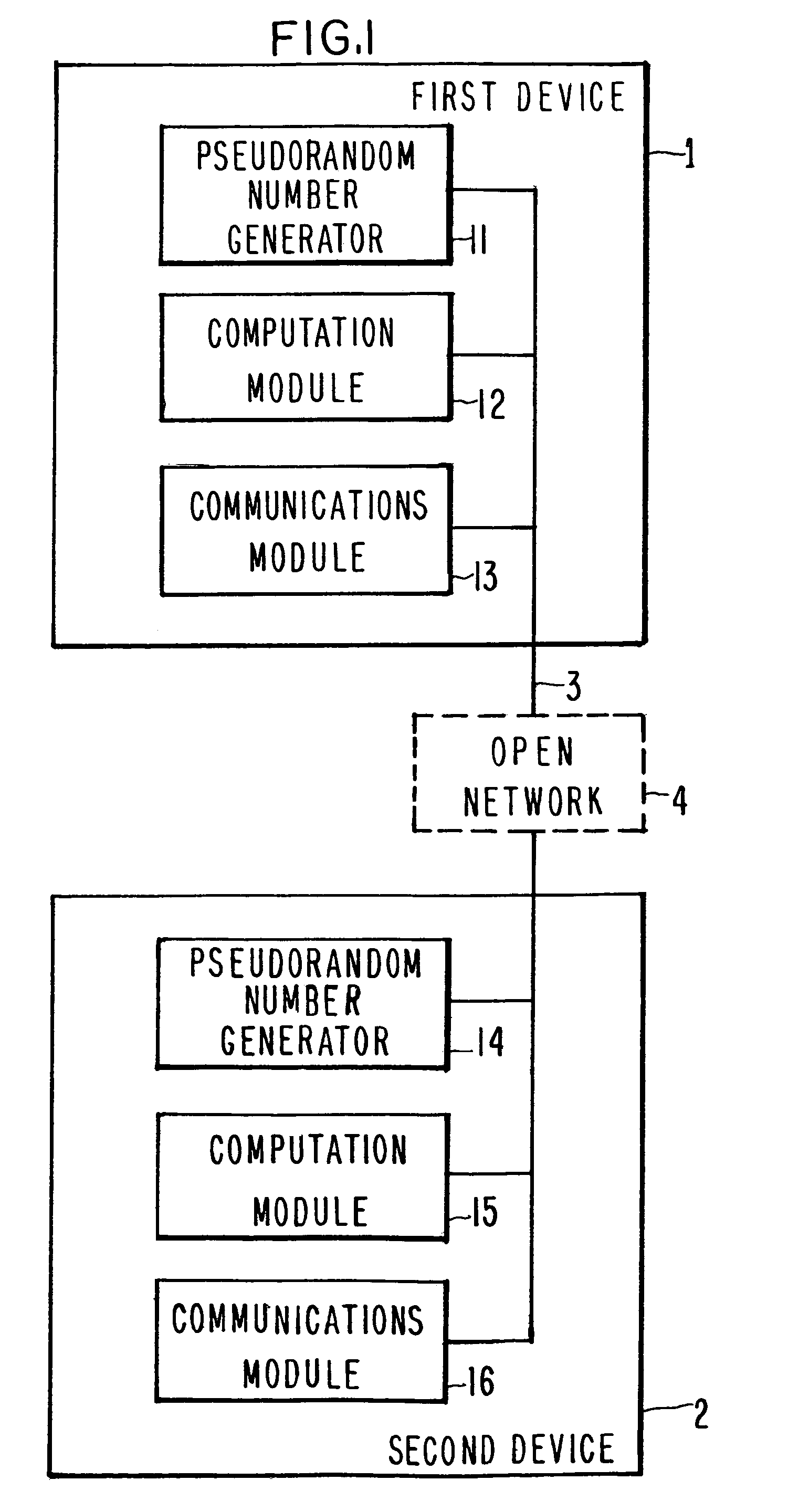Cryptosystems using commuting pairs in a monoid
a cryptosystem and commuting pair technology, applied in the field of cryptosystems using commuting pairs in a, can solve the problems of inability to compute relatively slow key cryptography, and inability to derive the private key from the public key
- Summary
- Abstract
- Description
- Claims
- Application Information
AI Technical Summary
Problems solved by technology
Method used
Image
Examples
first embodiment
[0095]FIG. 4 is a flow diagram showing the First Key Exchange Algorithm using matrices over a hyperbolic ring described above. In this embodiment, we take Y=Z={1} so that any endomorphism or antiendomorphism satisfies the condition described in the First Key Exchange Algorithm. We take an invertible matrix P and take our endomorphism h to be the composition of T(2) and the conjugation by P, i.e., h(x)=PT(2)(x)P−1. We select an invertible matrix Q for our element g. With these choices, the public keys are u=hc(Qn) and v=hd(Qs), and the private keys are the pairs of integers (c,n) and (d,s). If we choose P in such a way that T(2)2(P)=P, then hc(Qn) can be computed efficiently using a square-and-multiply type technique. If L denotes the subfield of F consisting of elements f2(x)=x, then any matrix P with entries from L[u,v] (i.e., polynomials in u and v with coefficients from L) satisfies the condition T(2)2(P)=P.
[0096]At step 41, devices 1,2 jointly or severally select k, a, and b. At...
second embodiment
[0101]FIG. 5 is a flow diagram showing the First Key Exchange Algorithm using matrices over a hyperbolic ring described above. In this embodiment, we again take h=identity so that any commuting pair can be chosen. Select an invertible matrix P, and take Y=Z={Pi:i is an integer}. We select an invertible matrix Q for our element g. With these choices, the public keys are u=PmQnP−m and v=PrQsP−r, and the private keys are the pairs of integers (m,n) and (r,s). The computation of the public keys can be done efficiently using a square-and-multiply method. In this embodiment, we may also take Y=Z=k[P], where k denotes the center of the ring Mat2(R), and k[P] denotes the ring of all polynomials in P with coefficients from k. For example, Alice can choose (Pm+Pq,n) as her private key, and send to Bob her public key (Pm+Pq)Qn(Pm+Pq)−1. We may also choose other commuting pairs, e.g. Y=Z={[x,0|0,x]: x in F(t)}, i.e., scalar matrices with diagonal entries from F(t).
[0102]At step 51, devices 1,2 ...
third embodiment
[0107]FIG. 6 is a flow diagram showing the First Key Exchange Algorithm using matrices over a hyperbolic ring described above. In this embodiment, we take h=T(2) and Y=Z={Pi: i is an integer}, where P=[u,0|0,u]. We take any Q for our base element g. With these choices, the public keys are u=T(2)c(PmQnP−m) and v=T(2)d(PrQsP−r), and the private keys are the triples of integers (c,m,n) and (d,r,s). The computation of the public keys can be done efficiently using a square-and-multiply method. In this embodiment, we may take any invertible matrix P with entries from k[u,v], where k denotes the center of the ring R and k[u,v] denotes the ring of all polynomials in two variables u and v with coefficients from k. Our particular choice of P is to make computations simple.
[0108]At step 61, devices 1, 2 jointly or severally select k, a, and b. At step 62, devices 1,2 jointly or severally select Q, P, and h. k, a, b, Q, P, and h are transmitted to each device 1,2 if they weren't generated joint...
PUM
 Login to View More
Login to View More Abstract
Description
Claims
Application Information
 Login to View More
Login to View More - R&D
- Intellectual Property
- Life Sciences
- Materials
- Tech Scout
- Unparalleled Data Quality
- Higher Quality Content
- 60% Fewer Hallucinations
Browse by: Latest US Patents, China's latest patents, Technical Efficacy Thesaurus, Application Domain, Technology Topic, Popular Technical Reports.
© 2025 PatSnap. All rights reserved.Legal|Privacy policy|Modern Slavery Act Transparency Statement|Sitemap|About US| Contact US: help@patsnap.com



